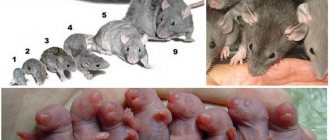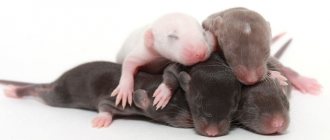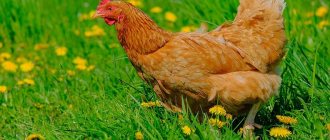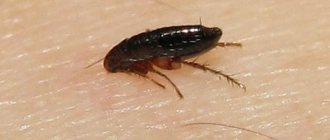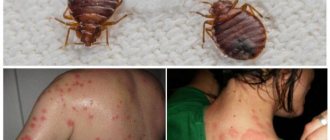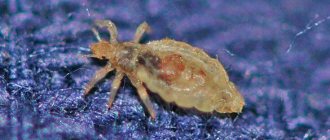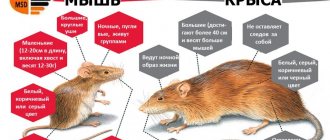Most pet rodent owners are concerned about the proper development of their rat pups. In this article, we will take a detailed look at the stages of development of baby rats, the rules for caring for them, and when they are ready to start interacting with their owners. We will also learn how newborn rats behave and learn how to properly care for them.
In addition, we will answer common questions from owners, such as “when do newborn rodents open their eyes?” and “what should I feed them?” And most importantly, we will learn what needs to be done to ensure that the baby grows up to be a healthy and happy rat.
How many pups are usually in a litter?
Typically, wild rats produce offspring ranging from four to eight pups. However, well-cared for pet rats can have litters that exceed this limit.
Female rats have 12 teats (even more than mice, cats and dogs), so they are capable of raising a large number of newborn rat pups. For this reason, most owners will not have to feed their young.
Content nuances
As soon as the pets are three weeks old, you can pick up the babies. The more you accustom them to your hands, the more affectionate and obedient they will be. The main thing here is not to overdo it. Measure is good in everything. Excessive squeezing can cause stress to the animal.
For a month, mother and babies should not be placed in different cages. Their immunity depends on how long children stay with their mother.
Like dogs, rats grow up to about a year old. When they are a month old, you can introduce cottage cheese, boiled chicken bones, apples, milk corn, and bananas into the babies’ diet. But it is better not to offer yolks, broccoli, lettuce, cucumbers, liver, tomatoes to young offspring.
Follow these recommendations until approximately three months of age.
Rats are very unpretentious animals and caring for a rat family is not at all difficult, the main thing is not to touch anyone with your hands in the first month, and then have time to seat the animals until the new generation brings you new offspring.
Source
What do newborn rat pups look like?
On the day they are born, newborn rats can easily fit into a teaspoon. Their eyes are completely closed and their ears are flat against their head. The tail of an animal at birth is much shorter relative to body length than that of an adult rodent.
Newborn rats have baby teeth and antennae, but no hair or skin pigment. For this reason, all cubs first have pink bodies. Their skin is so thin and transparent that you can see the shape of their eyeballs through their eyelids. Many owners also note that milk is clearly visible in their tummies after feeding.
Stages of development of baby rats
Before rats can leave their mother, they must develop properly. Cubs usually develop quite quickly physically and mentally. It is very interesting to observe such a transition of a rat from a defenseless animal to a full-fledged adult. Let's look at the development of rats week by week:
- First week
The pigment begins to appear on the skin almost immediately after the animal is born. However, only after five days can peach hairs be seen on the body of a newborn rat.
Until 5 days of age, the rodent practically does not move. He can only raise his head and fall back down onto his stomach if he fails to rise.
Although these newborn rodents lack vision and hearing, they use their whiskers to find their mother's nipple or their siblings.
- Second week
The baby rats begin to develop full-fledged fur. They can also now stand up on their feet. At the end of the second week, baby rats usually take their first steps.
However, another big change awaits them. On the tenth day, the ears stop pressing against the head, and on the twelfth day, the ear canal begins to open.
- Third week
At the beginning of the third week, the rat's weight should exceed 4 times its birth weight. Also, their sense of smell and taste will be almost fully developed by this age. In addition, their eyes should open completely.
- Fourth week
Once the pups reach 4 weeks of age, they become more and more like adults. By the end of this week, their fragile tails will become stronger and more coordinated. The baby rodent hairs will be replaced by thick fur and undercoat.
The little rats are filled with energy and want to explore everything around them. Another important point is that at this age they wean themselves from drinking their mother’s milk. Therefore, the female will spend significantly more time outside the nest.
- Fifth week
At this stage, rats begin to demand solid food. They no longer need milk alone to get energy.
They also begin to spend a lot of time grooming, digging, playing with their siblings, and asserting their independence. By the end of this week, it is important to separate the males from the females as the rats reach sexual maturity. Also, the fifth week is the most important for the development of social skills in the rodent.
- Sixth week
At 6 weeks of age, rats are ready to leave home and go to new owners. They get rid of their childhood habits and no longer need their mother's milk.
Between six and eight years of age, baby rats go through the equivalent of puberty and adolescence. After this period they can be considered adults.
Birth
At the second stage of being in an interesting position, it is not recommended to disturb the female, namely:
- move the cell;
- pick up and so on.
This leads to termination of pregnancy.
In the process of bearing offspring, the female needs rest and a balanced diet.
The total gestation time of a rat is 23 days. By the time it ends, a number of hormonal changes are completed in the animal’s body. As for the external features of hormonal changes, they look like this:
- The female becomes somewhat nervous at the sound of someone else's baby squeaking.
- The creation of a nest for delivery is carried out by the animal independently a couple of hours before the start of the process.
- An interesting thing is that if during this period you place someone else’s baby next to the female, the expectant mother will accept him with great pleasure, despite the fact that she has not yet produced milk.
- During this period, the animal’s hostility towards any other animals increases significantly.
The female needs rest during delivery. Fear leads to spasms of the uterus and can provoke the death of an adult. Pathologies during delivery occur due to the non-standard position of the fetus. Often, the death of a female in the prepartum position occurs due to the decomposition of the non-surviving fetus or during pregnancy outside the uterus.
The traditional duration of birth for a rat is 2-3 hours. Before delivery, bloody fluid is released from the female’s perineum, after which the animal feels a contraction. The body is stretched and the sides are stretched to the limit.
Before the immediate appearance of the rat pups, the female sits down and assists their exit using her paws and teeth. The animal also pulls out the birth sac on its own, and then proceeds to the pups: licks them and gnaws the umbilical cord of each one. Experts note that after birth, the animals eat the placenta and umbilical cord. During the birth process, the baby begins to move and make sounds; these kinds of signals show the female that he is viable, and she cannot eat him.
Why do baby rats cuddle together?
Looking inside a baby rat's nest, you can hardly tell where one baby ends and the next begins. It's a truly fascinating instinct that serves an important purpose. Small rodents do not have fur, so they quickly lose heat. By clinging to each other, they prevent heat loss.
By doing this, newborn rats also expend less energy on maintaining heat. They subsequently invest this energy in the development of the body.
What do baby rats sound like?
So, we learned that baby rats can hear, but what sounds do they make themselves?
From an early age, rats use ultrasonic vocalizations to signal to their mother that they are cold, lonely or low on milk. These squeak-like sounds are far beyond our audibility. However, an adult rat distinguishes them with ease. This is a fairly important part of the behavior of baby rats.
Keep this in mind if you ever disturb a baby rat's nest. Just because you don't hear their protests doesn't mean they are happy with your behavior. And, if you hear baby rats squeaking, you need to leave.
Possible problems during pregnancy
The owner of the rodent needs to closely monitor its condition. In most cases, pregnancy proceeds normally, but sometimes complications occur. Health problems can be caused by stress.
Situations in which urgent veterinary care is needed:
- the rat is lethargic, does not eat anything;
- pus or blood is released from the genital loop;
- the baby rats do not move in the stomach - this can be detected at the end of pregnancy;
- labor lasts more than 5 hours.
What to feed the baby rats?
Rats need nothing more than their mother's milk to grow until they are 21 days old.
Orphaned rats can be raised on formula after consulting with a veterinarian about the proper diet.
At 21 days they are ready to try their first solid food. They usually start with something soft and light, like yogurt, a ripe banana, or their mother's regular rat pellets. You can soften them for easier consumption by your baby rats.
However, these products do not replace breast milk overnight. They will continue to feed from their mother for several more weeks.
Factors affecting reproduction
In the wild, the number of times a rat gives birth per year is influenced by climatic conditions, availability of food in the right quantities, natural disasters, and environmental conditions. We must not forget that natural selection allows only strong cubs to survive.
At home, despite the fact that rats are not so dependent on external factors, breeders try to limit the number of pregnancies, since frequent births affect the health of pets.
The birth of healthy rat pups and their number are influenced by the air temperature in the apartment, humidity, balanced nutrition, and stressful situations. Genetic factors also play a role. Spontaneous mutations and hidden recessions may occur.
When do rats open their eyes?
Even when the eyelids are closed, the eyes of newborn rats are sensitive to light. If you suddenly let light into their nest, you will notice that they try to isolate themselves from the light as much as possible, depending on their stage of development.
They usually finally open their eyes around the 15th day after birth. Now they can see normally, although it may seem different to us. This is because their vision is much worse than ours. But what’s interesting is that their viewing angle is much wider. It even includes the area above their heads, as well as in front of them and to the sides.
Character and lifestyle
Since Dumbo is not a separate species of animal, but only one of the rat breeds, the same traits can be traced in their character as in ordinary rodents:
- intelligence
- sociability
- good sense of smell
- friendliness
Dumbo is distinguished from its relatives by its inactivity and low activity. Although there are often exceptions to this rule.
Rodents need communication; they should be given at least 2 hours every day. Otherwise, rats may get bored and stop eating. If the future owner does not have so much time, he can buy a friend for his pet.
Socialization of young rats
Rats should always be kept in pairs or large groups throughout their lives. Playing with their littermates is a vital part of baby rats' social development. Lack of company and interaction with other rats is a huge stress for them. This is largely due to the fact that rats kept in isolation as they grow up do not acquire the social skills needed to live peacefully with other rats.
So responsible breeders always make sure that the little rat is in the company of the younger generation. This way, they will grow up to be healthy and sociable individuals. This does affect the behavior of the baby rats as they get older.
What not to give
Often, owners of baby rats try to pamper the younger generation with something tasty. However, most delicacies from the human table are dangerous for rodents, especially for babies. The following are strictly prohibited:
- sugar and sweets - candies, milk chocolate, baked goods, ice cream, condensed milk;
- fatty meat, lard;
- semi-finished products - dumplings, dumplings, cutlets;
- sausages, sausages, smoked meats;
- fast food;
- dried, smoked, dried fish;
- fresh milk;
- mushrooms;
- radishes, beans, turnips, rhubarb;
- carbonated drinks.
You also need to carefully monitor the baby rats so that they do not eat forbidden foods. Some plants, for example, can be deadly for rats - aloe, lily of the valley, dieffenbachia, geranium, carnation, lupine, tulip.
A new addition to a rat family is a very important and responsible event. Knowing what to feed baby rats and how to care for them, even a novice breeder can raise healthy and active offspring without any problems.
Source
How long should baby rats stay with their mothers?
Usually six weeks. This includes a period of nursing the cubs and their final weaning after approximately 5 weeks (21 days).
Many people ask this question, especially when they find orphan rats. What to do if you find orphan rats? How to feed them? As mentioned earlier, if the mother is unable to nurse, you can feed the rat baby formula. Just be sure to seek help from a veterinarian.
Diseases and treatment
If the animal is sick, it is quite easy to see. So, a healthy rat is active, has shiny fur and shiny eyes. When an animal feels unwell, the following symptoms appear:
- poor appetite or refusal to eat;
- sluggish appearance;
- strong unpleasant odor of excrement;
- dull coat, etc.
If you notice signs of illness in your pet, contact your veterinarian immediately. Don't forget: some rodent diseases are dangerous to humans.
The most common infectious diseases of rats are:
| Name | Symptoms | Treatment |
| Mycoplasmosis | sneezing; discharge of a specific color from the nose and eyes; labored breathing; lethargy, etc. | Antibiotics, hormones, anti-inflammatory drugs prescribed by a doctor. If left untreated, the disease can be fatal to the rodent. |
| Rabies | lethargy followed by frantic activity; fear of bright light; aggression, etc. | The disease is incurable, the rodent must be euthanized, and the room where it was kept must be disinfected to avoid infecting other animals and people. |
| Pneumonia | sneezing; discharge of a specific color from the nose and eyes; labored breathing; refusal of food; increased drowsiness. | Antibiotics, anti-inflammatory drugs prescribed by a doctor. |
How to care for baby rats?
Knowing how to care for baby rats is an important part of rat ownership. There are four main aspects of caring for newborn animals:
- Finding suitable housing
: If you live in a house, especially if you have other pets, you need to keep your baby rats safe. For them you need to purchase a cage (experts recommend 75 cubic centimeters per rat). The cage should be made of wire with holes of at least half a centimeter between the rods. Don't forget to take care of other things such as litter, tunnels, and a place for the rodent to play. - Taking care of their health
: The early days are critical to ensuring your pet's health, so it is recommended that you take your rat to the vet as soon as possible. Once the preliminary visits are completed, it is recommended that you see a specialist every six months. - Socialization
: To make your pet comfortable, be sure to find him another rat friend or littermate. For your part, be careful with your rats - handle them carefully and, of course, use positive reinforcement. Treats always work better than punishment. - Feeding baby rats
: Baby rats only need milk or formula for early development. Once your rat is weaned, you will need to find the best way to feed it using suitable rat kibble.
Let's now look at the aspects of caring for baby rats in more detail.
Signs of approaching labor
For a comfortable birth and calm care of the babies, the rat needs to prepare a separate cage where no one will disturb it. It is better to transplant a pregnant female a couple of weeks before giving birth, so that she has time to prepare the nest and get used to the new territory.
You can understand that the deadline is approaching by the behavior of the animal. He becomes aggressive, takes food from his relatives, and frees up the space he likes for himself. The rat begins to arrange the place where the babies will be born. A few hours before giving birth, mucus drains from the vulva.
Can baby rats drink cow's milk?
No, cow's milk is not recommended for baby rats. It does not contain enough nutrients that are good for your rat. However, infant formula has been used successfully for babies. If a female's milk is not available and you can't find a surrogate rat mom, stick to formula until they reach weaning age.
Please note that after feeding the baby rat, you need to periodically stroke its tummy with a warm, damp cloth. This improves digestion and helps the babies defecate when they are still very young.
